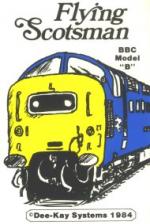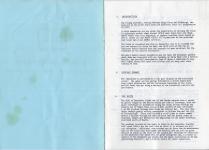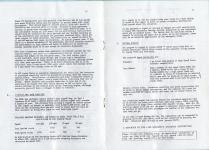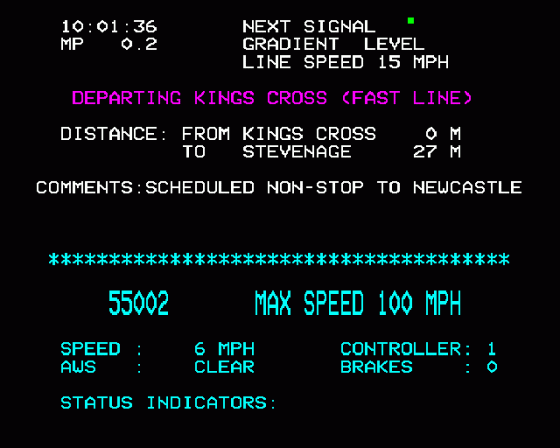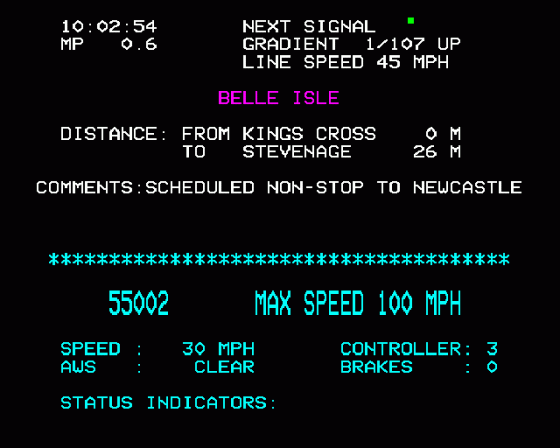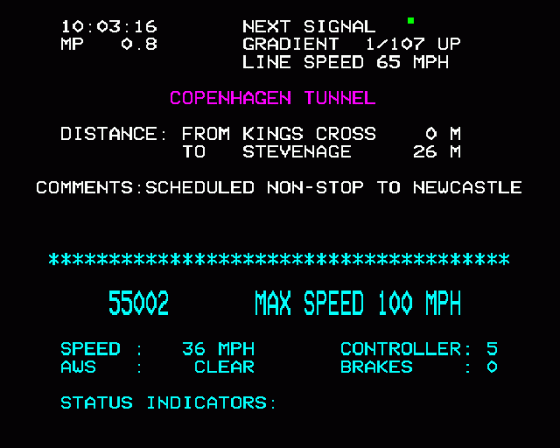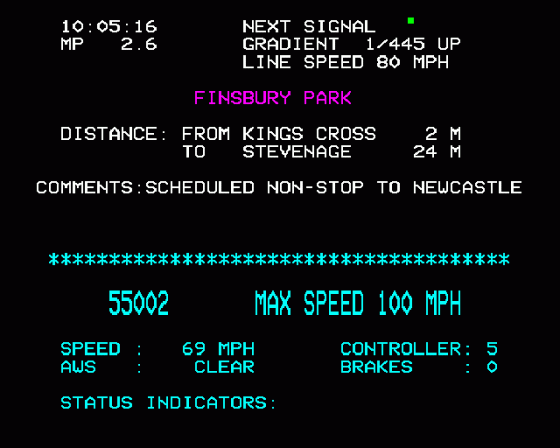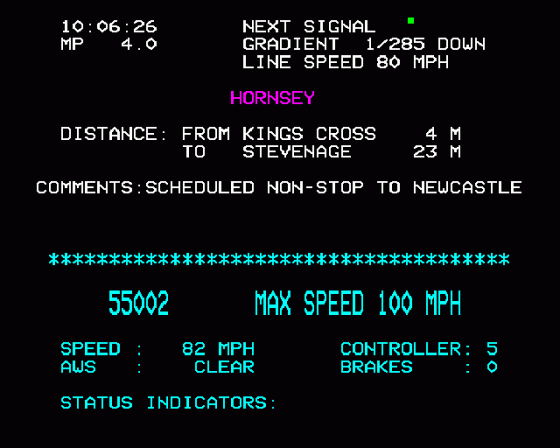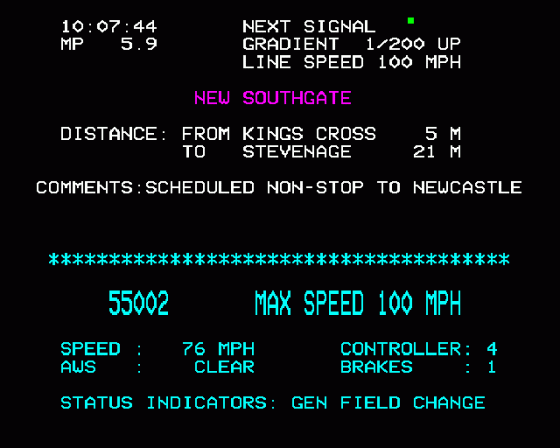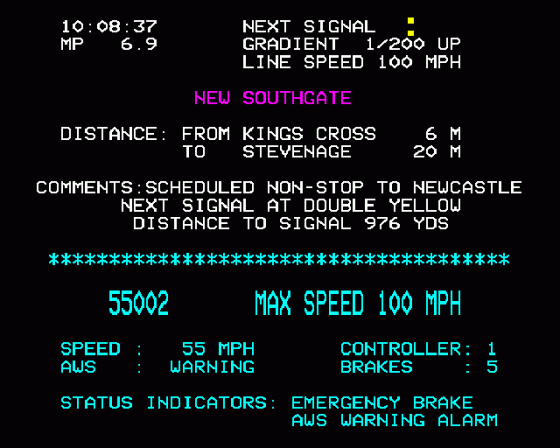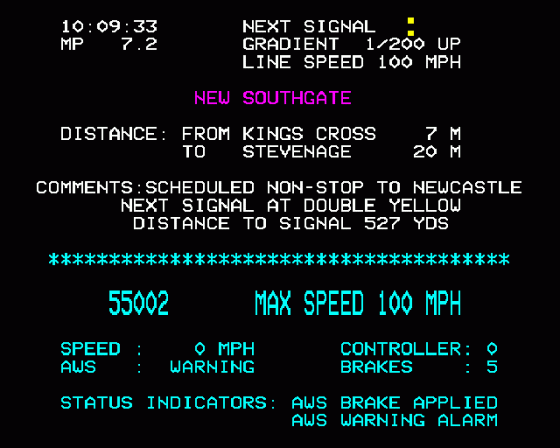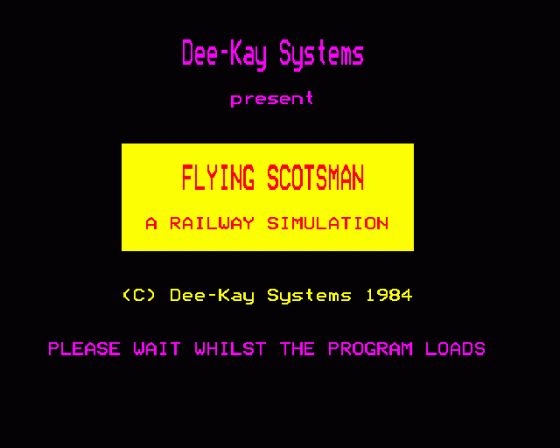
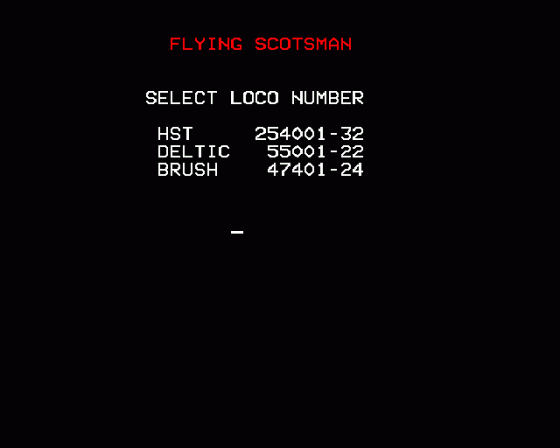
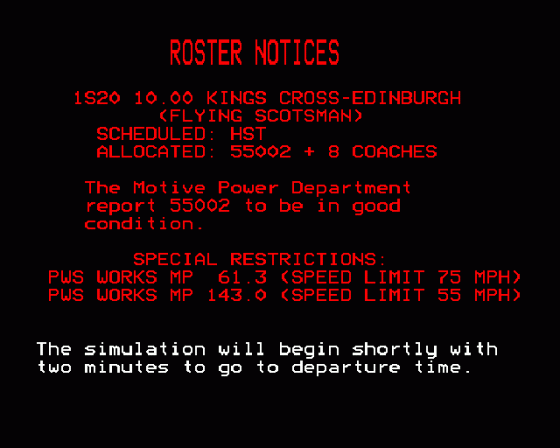
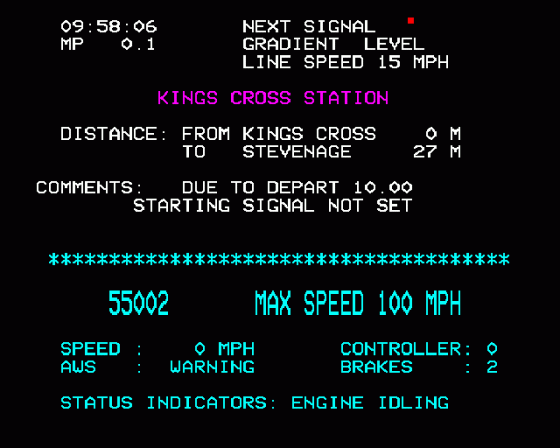
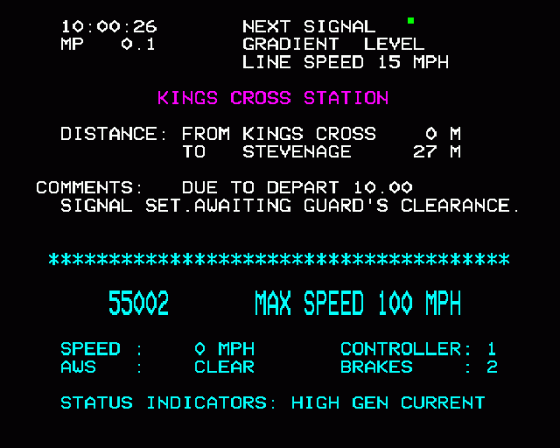
| Genre: | Game: Simulation |
| Publisher: | Deekay |
| Cover Art Language: | English |
| Machine Compatibility: | BBC Model B |
| Release: | Professionally released on Cassette |
| Available For: | BBC Model B, BBC/Electron & Spectrum 48K |
| Compatible Emulators: | BeebEm (PC (Windows)) PcBBC (PC (MS-DOS)) Model B Emulator (PC (Windows)) |
| Original Release Date: | 11th April 1984 |
| Original Release Price: | £7.50 |
| Market Valuation: | £2.50 (How Is This Calculated?) |
| Item Weight: | 64g |
| Box Type: | Cassette Single Plastic Black |
| Author(s): | - |
Variant Items
There are 0 other items featuring this same game (that we know about!). Click any of them for their details.
Active Auctions
Closed Auctions
Buy It
Unfortunately no-one is currently selling this item.
Auction Price Watch
Worried you're being ripped off? Closing prices on eBay can help you decide what a reasonable price is for a particular item.

A&B Computing
1st January 1985
An interesting, if not brilliantly realised, piece of software. Read Review
Full Instructions
1. Introduction
The Flying Scotsman, running between Kings Cross and Edinburgh, has been one of the prime Anglo-Scottish expresses since its inauguration in 1862.
In this simulation you are given the opportunity of driving the train in relatively modern times around 1978-9 when Inter-City 125 (High Speed Tain) sets were beginning to replace coaching stock hauled by Deltic (Class 55) and Brush (Class 47) locomotives on the principal East Coast mainline (ECML) services.
The train is scheduled non-stop to Newcastle, but it is assumed that you are rostered to drive for only the first part of the run to Doncaster before handing over the controls to your co-driver for the remainder of the journey northwards.
Driving a modern diesel locomotive may not have the nostalgic glamour which some may associate with say storming up Stoke Bank with a Gresley Pacific, but you will nevertheless find it quite a challenge to cope with signal checks and speed restrictions and yet keep your train running to time.
2. Display Format
The simulation is presented as a two part display on the television screen: the upper section giving information a driver would have from visual observation and his background knowledge of the route, and the lower section being a monitor of the locomotive controls and performance.
3. The Route
The ECML to Doncaster climbs out of the London suburbs over a series of gravel ridges to the Hertfordshire new town of Stevenage, with the major challenges to locomotives being the steep incline through the tunnels out of Kings Cross and an 8 mile stretch of near continuous 1 in 200 gradient between Wood Green and Potters Bar. The line then drops through gently-rolling countryside to Stilton Fen and the city of Peterborough. There then follows a stiff climb to Stoke summit before a descent through the Vale of Trent and the market towns of Grantham, Newark and Retford to the beginnings of the South Yorkshire coalfield north of Bawtry.
Restrictions are in force due to maintenance work on the track near Huntingdon and Retford, you will be given details of these at the start of the simulation. Warnings of reductions in the permitted line speed will be given during the run, 1.5 miles in advance of the permanent way slacks and the major restrictions to 60mph approaching Doncaster, and 1.0 miles before all other restrictions.
4. Schedules
Two schedules are available in the simulation; one destined for HST power and the other for a locomotive hauled formation of 11 coaches weighing 385 tons. Details of the passing times of the principal locations and of the recovery allowances built into the schedules are given in the Appendix, and during the run you will be given reports on your progress as you reach the various timing points.
Either HST, Deltic or Class 47 power may be selected for your chosen schedule (Electron owners only have HST or Deltic facility with their machine). If a Deltic or Class 47 is specified for the locomotive hauled schedule, the train will comprise the planned 11 coaches, but if these classes are chosen to run on the HST schedule it will be assumed that the train is a substitute for a failed HST set and a lower capacity 8 coach formation will be provided for the journey. HSTs will, of course, have plenty in hand if selected for the locomotive hauled schedule, the Class 47s (which in practice only worked the Scotsman when the rostered HST or Deltic was unavailable) will struggle to keep time on even the locomotive hauled schedule, never mind the more demanding HST schedule.
5. Motive Power And Coaching Stock
| Deltic | Class 47 | HST | |
| BR Designation | 55 | 47/4 | 254 |
| No. available in simulation |
55001-22 | 47401-24 | 254001-32* |
| Builder | English Electric | Brush | BREL |
| Introduced | 1961 | 1962 | 1977 |
| Axle type | Co-Co | Co-Co | Bo-Bo |
| Engines | Napier Deltic | Sulzer | Paxman Valenta |
| Horsepower | 3,300 | 2,580 | 4,500+ |
| Max Speed (mph) | 100 | 95 | 125 |
| Length | 69' 6" | 63' 7" | 58' 5" |
| Height | 12' 10" | 12' 9.5" | 12' 9" |
| Width | 8' 9.5" | 9' 2" | 8' 11" |
| Weight (tons) | 100 | 121 | 70 |
* For details of power cars allocated to individual sets see Modern Railways Pictorial Profile: 1 High Speed Trains, Pulb. Ian allan (1983), + From 2 power cars
The class 254 HST sets are the standard East Cost formations with 8 essentially Mk III coaches. The stock for the locomotive hauled trains is late-type Mk II air conditioned coaches. Appropriate resistance curves for near still air are assumed, with an ETH/air conditioning load of 24Kw per coach.
6. Locomotive Controls
For simplicity, all locomotives in the simulation have been given a standardised controller with five power settings (1-5) rather than the differing notch systems of the originals. The braking system is similar but position 5 is for emergency only, the maximum application in normal service being position 4.
> - Increase Speed, < - Decrease Speed, X/Z - Brakes
Use SHIFT for horn, a short press for one note and longer for two tone horn
7. Driving Technique
The tractive characteristics of the different locomotive classes are realistically reproduced in the simulation and as such it is necessary to become familiar with the individual handling responses.
Deltics had their engines optimized for high speed running and were notoriously poor (as well as at times messy) starters. Gentle handling is needed to avoid overloading the generator, which in this simulation drops out a contactor and returns the controller to the idling setting. As a consequence, power should gradually be increased from notch 1 to start up to full power (notch 5) between 18 and 20mph. A warning of high generator current (which corresponds to between 2000 and 2400 amps compared with the continuous rating of the generator of 1650 amps_ means that the controller should not be notched up further at that speed, and the current should only be kept in this range for short periods at a time.
Generator field diversion occurs at appropriate load values, which on full power acceleration correspond to speeds of about 51 and 77mph; brief notification is given but no action is required.
The maximum speed limit of the Deltics of 100mph was closely adhered to for most of their lifetime, but around the time of this simulation, when much of the line was approved for faster running and schedules were based on the full power capacity of the locomotives, it was not unknown to experience excesses of 5-10mph. An overspeed trip is however fitted in the simulation to avoid major engine damage.
Class 47 locomotives are less powerful than Deltics but as low speeds have more tractive effort and are quicker to attain their full rated horsepower. They should again be started gently, with full (notch 5) controller not selected until 12-14mph. Warning of high generator current is given when the ammeter is in the range 3000-3750amps (c.g. the continuous rating of 2130amps), but as with Deltics such currents should only be sustained for short periods and any further notching up of the controller will activate the generator overload trip.
There the three stages of field diversion, and these occur at speeds of about 35, 45 and 60mph on full power acceleration. At speeds greater than 77mph there is a marked unloading of the generator, and this severely restricts the performance at high speeds and makes it difficult to exceed the nominal maximum speed of 95mph except on sustained downgrades.
HSTs have alternators rather than generators to provide current for the traction motors, and there is a sophisticated control system to co-ordinate the output of the two power cars. The full engine power is not available until above 30mph, and if too high a controller setting is selected at lower speeds an automatic current limiting sysem will come into operation. There is no field diversion, and it is an electronic trip fitted to all ECML units which limits the maximum speed to 3mph above the nominal value of 125mph.
On all types there is automatic compensation for wheelslip, but excessive of prolonged wheelslip should be avoided by notching down the controller appropriately. Notification of wheelslip and other locomotive events is given on the control panel, with a clear display indicating that all is normal. Major failures are possible from time to time and if you experience an engine shutdown whilst driving an HST or Deltic you should continue on the reduced power of the remaining engine, although naturally you will have a struggle to keep to schedule.
8. Signalling And Braking
The ECML has multiple aspect colour-light signalling so that a sequence of at least a double yellow and a yellow signal will precede a signal at red. The distance from passing a signal at double yellow to the signal at danger is generally only 2,200 - 2,400 yards, and as shown by the following data you will need to brake hard for much of this distance to bring your train to rest from high speed.
Specimen braking distances (in yards) on level track for a full application of the service brake.
| Speed | 125mph | 100mph | 70mph | 30mph |
| Loco hauled train | - | 1933 | 931 | 140 |
| High speed train | 1931 | 1244 | 602 | 97 |
An application of the emergency brake will shorten these distances by about 20%, whilst on a 1:200 downgrade stopping distances are increased by about 10%.
If a signal is at red, you should bring your train to a halt within 35 yards of the signal in order to obtain telephone instructions form control about the situation.
As you approach a signal a caution you will receive a visual A.W.S. (Automatic Warning System) indication on the instrument panel and in the case of BBC owners an audible warning also. This must be cancelled within 6 seconds by pressing Space bar (BBC and Electron only) or 0 (Zero, Spectrum and Commodore) - or else, as on the original there will be an automatic application of the emergency brake.
9. Getting Started
PAGE = &E00
CHAIN""
The required input parameters are:
Schedule
L or H for loco-hauled or High Speed Train schedule respectively.
Loco Number
Type a number in the range 55001-55022 for a Deltic, 47424 for a Class 47 and
254001-254032 for a High Speed Train set. If a Deltic or Class 47 locomotive is selected
with L you will be given an 11 coach train; if they are selected with H you will be given
an eight coach train.
Details of your train, locomotive condition and speed restrictions will be given as a "Roster Board" information, and the computer will make its random selection of signal checks and other out of course events for your run.
The simulation begins two minutes before the scheduled departure time of 10:00 with the train (with official reporting number 1S20) standing in Platform 8 of Kings Cross station with engines idling. Wait for the starting signal to be set and the guard's clearance (which may of course be delayed if there are late passengers or loading is not complete) and then away you do.
If you want a break during the run, the simulation can be suspended by pressing the H key (for Hold), with action restarted by pressing the R key. Otherwise, good driving on your journey.
A Reminder Of The Line Manager's Standing Instruction
When trains are running late, drivers must endeavour to make up time with due regard to all speed restrictions and braking capability of the train.
Schedule
1S20 10:00 Kings Cross-Edinburgh
| Distance (miles) |
Location | Scheduled Time | |
| HST | LH(D385+) | ||
| 0.0 | Kings Cross | Dep 10:00:00 | 10:00:00 |
| 12.7 | Potters Bar | Pass 10:11:30 | 10:14:00 |
| 20.3 | Welwyn Garden City | Pass 10:16:00 | 10:19:00 |
| 31.9 | Hitchin | Pass 10:22:00 | 10:26:30 |
| 58.9 | Huntingdon | Pass 10:36:00 | 10:43:00 |
| (Recovery Time + 4 min) |
|||
| 76.4 | Peterborough | Pass 10:49:30 | 10:58:00 |
| 100.0 | Stoke Summit | Pass 11:01:30 | 11:14:00 |
| 105.5 | Grantham | Pass 11:05:30 | 11:17:30 |
| 120.1 | Newark | Pass 11:13:00 | 11:26:30 |
| 138.6 | Retford | Pass 11:24:00 | 11:39:30 |
| (Recovery Time + 4 min) |
|||
| 156.0 | Doncaster | Pass 11:38:30 | 11:56:30 |
Screen Designers
The following utilities are also available to allow you to edit the supplied screens of this game:
Cheats
Download
A digital version of this item can be downloaded right here at Everygamegoing (All our downloads are in .zip format).
| Download | What It Contains |
|---|---|
| A digital version of Flying Scotsman suitable for BeebEm (PC (Windows)), PcBBC (PC (MS-DOS)), Model B Emulator (PC (Windows)) |
Report A Problem
We thank you from the bottom of our hearts if you report something wrong on our site. It's the only way we can fix any problems!
You are not currently logged in so your report will be anonymous.
Add Note
Release Country
Change the country to update it. Click outside of this pop-up to cancel.
Scan Of Selected Article
If you auction an item, it will no longer show in the regular shop section of the site.

